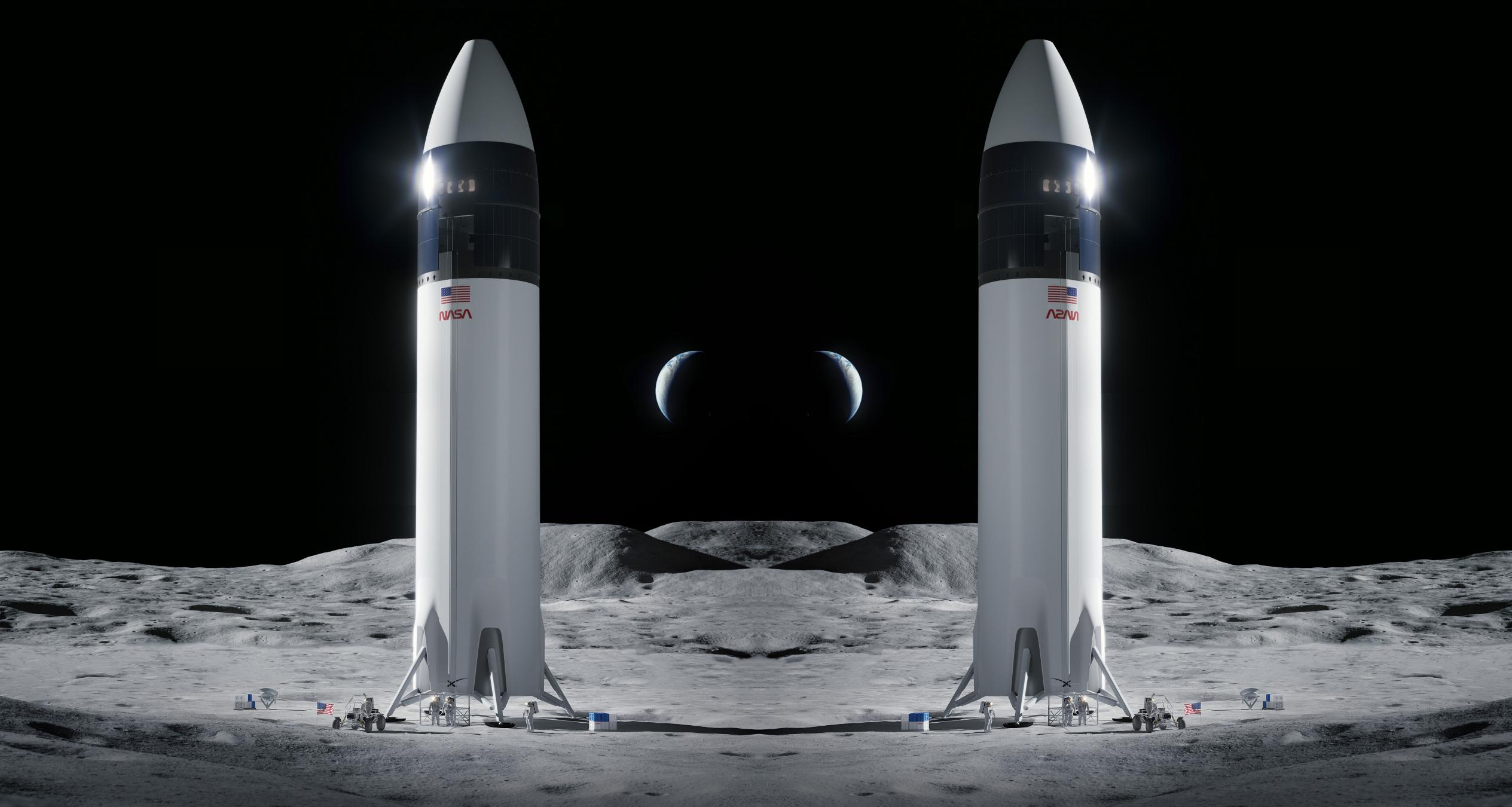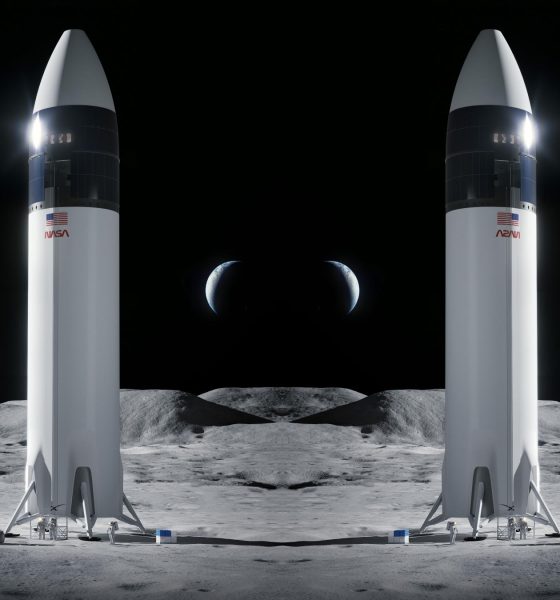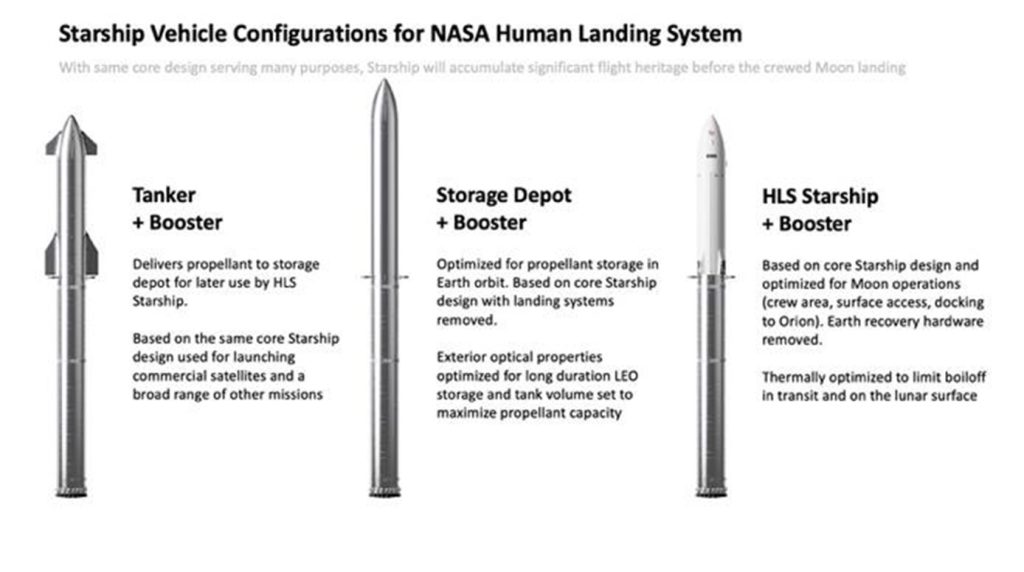

News
SpaceX, NASA finalize contract for second crewed Starship Moon landing
Around eight months after announcing its intention to do so, NASA has awarded SpaceX a contract for a second crewed Starship Moon landing as early as 2027.
Known as Option B, NASA has exercised a baked-in right to modify its Human Landing System (HLS) Option A contract with SpaceX – signed in April 2021 – to extract even more value from investments into the program. In addition to an uncrewed Starship Moon landing planned no earlier than (NET) 2024 and a crewed demonstration that could land two NASA astronauts on the Moon as early as 2025, NASA’s contract modification gives SpaceX the approval and resources it needs to prepare for a second crewed Starship Moon landing.
On top of securing NASA’s Artemis IV mission astronauts a ride to the lunar surface, the Option B contract will also allow SpaceX and NASA to pursue and demonstrate upgrades that will make Starship an even more capable and cost-effective Moon lander.
Update: NASA says that the Option B modification will cost $1.15 billion, raising the maximum value of SpaceX’s HLS contract to approximately $4.2 billion.
When NASA first announced its intention to add a second crewed Moon landing to SpaceX’s existing HLS contract, the agency couldn’t offer specific information about when that landing might occur or which Artemis mission it would be attached to. Part of the reason for that uncertainty was another announcement two months prior that NASA no longer expected a Moon landing to be paired with its Artemis IV (4) mission. And five days after a March 2022 announcement of plans for a second crewed Starship Moon landing, NASA seemingly reaffirmed that there would be a multi-year gap between Starship’s first crewed Moon landing (NET 2025; tied to Artemis III) and NASA’s second crewed Moon landing, which would use an unspecified lander.
But as of November 2022, NASA has thankfully abandoned plans to intentionally allow a gap between Moon landings. SpaceX’s Starship is now on contract to support back-to-back crewed Moon landings NET 2025 and 2027 as part of NASA’s Artemis III and Artemis IV missions. It’s unclear how or why NASA was able to make that change, but it’s a definite improvement over the alternative.

Additionally, NASA will work with SpaceX to debut new capabilities and improvements on Starship’s second crewed Moon landing. While the Artemis III landing will be about as barebones as possible, the Artemis IV Starship will be upgraded with the ability to transport more NASA astronauts (four instead of just two) and more cargo to the lunar surface. It’s not entirely clear, but NASA reportedly wants to land just ~180 kilograms (~400 lb) of cargo with the first crewed Starship, a vehicle likely capable of landing dozens of tons of cargo in addition to several astronauts. NASA hopes that future “sustainable” lander missions, a category that Starship’s Option B landing may or may not fall under, will transport up to one ton (~2200 lb) of cargo to and from the lunar surface.
Finally, the Artemis IV Starship will also be able to dock with NASA’s Lunar Gateway. Gateway is a small deep space station that will be located in a strange, high lunar orbit. It exists almost exclusively to give NASA’s Space Launch System (SLS) rocket and Orion crew capsule a destination they can both reach. The Orion capsule is almost twice as heavy as its Apollo counterpart and its European Service Module (ESM) offers less than half the performance of NASA’s retired Apollo Service Module. Combined, Orion is physically incapable of transporting itself (or astronauts) to the simpler low lunar orbits used by the Apollo Program.
Instead, NASA’s new Moon lander(s) have to pick up Orion’s slack. Starship will be responsible for picking up astronauts in a lunar near-rectilinear halo orbit (NRHO), transporting them to low lunar orbit, and returning them to NRHO in addition to landing on the Moon, spending a week on the surface, and launching back into lunar orbit.
Until it’s modestly upgraded in the late 2020s or 2030s, Gateway will be equally underwhelming. In fact, that’s part of the reason that Starship docking with the Gateway is in any way significant. SpaceX and NASA have decades of expertise docking and berthing spacecraft with space stations. But those spacecraft are typically smaller and lighter than the stations they were joining. Even after the Gateway is fully outfitted with a range of international modules, Starship will likely weigh several times more than the tiny station, making docking even more challenging than it already is.
Starship’s Moon lander variant could also have a cabin with hundreds of cubic meters of habitable space, while the Gateway is unlikely to ever have more than a few dozen. Having a Starship docked would thus immediately make the ultra-cramped station far more livable.
NASA says Artemis IV and the second crew Starship Moon landing will occur as early as 2027. But a ‘space prophet’ who predicted in 2017 that NASA’s SLS launch debut would slip from 2019 to “around 2023” and forecasted that SpaceX alone would win NASA’s Moon lander contract recently told Ars Technica’s Eric Berger that Artemis III, the mission before Artemis IV, is unlikely to launch before 2028. At the time, that source’s predictions verged on blasphemy, but they’ve ultimately proven to be eerily accurate. Only time will tell if their third ‘prophecy’ follows the same path.

News
SpaceX shades airline for seeking contract with Amazon’s Starlink rival

SpaceX employees, including its CEO Elon Musk, shaded American Airlines on social media this past weekend due to the company’s reported talks with Amazon’s Starlink rival, Leo.
Starlink has been adopted by several airlines, including United Airlines, Qatar Airways, Hawaiian Airlines, WestJet, Air France, airBaltic, and others. It has gained notoriety as an extremely solid, dependable, and reliable option for airline travel, as traditional options frequently cause users to lose connection to the internet.
Many airlines have made the switch, while others continue to mull the options available to them. American Airlines is one of them.
A report from Bloomberg indicates the airline is thinking of going with a Starlink rival owned by Amazon, called Leo. It was previously referred to as Project Kuiper.
American CEO Robert Isom said (via Bloomberg):
“While there’s Starlink, there are other low-Earth-orbit satellite opportunities that we can look at. We’re making sure that American is going to have what our customers need.”
Isom also said American has been in touch with Amazon about installing Leo on its aircraft, but he would not reveal the status of any discussions with the company.
The report caught the attention of Michael Nicolls, the Vice President of Starlink Engineering at SpaceX, who said:
“Only fly on airlines with good connectivity… and only one source of good connectivity at the moment…”
CEO Elon Musk replied to Nicolls by stating that American Airlines risks losing “a lot of customers if their connectivity solution fails.”
American Airlines will lose a lot of customers if their connectivity solution fails
— Elon Musk (@elonmusk) December 14, 2025
There are over 8,000 Starlink satellites in orbit currently, offering internet coverage in over 150 countries and territories globally. SpaceX expands its array of satellites nearly every week with launches from California and Florida, aiming to offer internet access to everyone across the globe.
Currently, the company is focusing on expanding into new markets, such as Africa and Asia.
News
Tesla Model Y Standard stuns in new range test, besting its Premium siblings
Tesla’s newer vehicles have continued to meet or exceed their EPA estimates. This is a drastic change, as every 2018-2023 model year Tesla that Edmunds assessed did not meet its range estimates.

The Tesla Model Y Standard stunned in a new range test performed by automotive media outlet Edmunds, besting all of its Premium siblings that are more expensive and more luxurious in terms of features.
Testing showed the Model Y Standard exceeded its EPA-estimated range rating of 321 miles, as Edmunds said it is the “longest-range Model Y that we’ve ever put on our loop.” In the past, some vehicles have come up short in comparison with EPA ranges; for example, the Model Y’s previous generation vehicle had an EPA-estimated range of 330 miles, but only drove 310.
Additionally, the Launch Series Model Y, the first configuration to be built in the “Juniper” program, landed perfectly on the EPA’s range estimates at 327 miles.
It was also more efficient than Premium offerings, as it utilized just 22.8 kWh to go 100 miles. The Launch Series used 26.8 kWh to travel the same distance.
It is tested using Edmunds’ traditional EV range testing procedure, which follows a strict route of 60 percent city and 40 percent highway driving. The average speed throughout the trip is 40 MPH, and the car is required to stay within 5 MPH of all posted speed limits.
Each car is also put in its most efficient drive setting, and the climate is kept on auto at 72 degrees.
“All of this most accurately represents the real-world driving that owners do day to day,” the publication says.
With this procedure, testing is as consistent as it can get. Of course, there are other factors, like temperature and traffic density. However, one thing is important to note: Tesla’s newer vehicles have continued to meet or exceed their EPA estimates. This is a drastic change, as every 2018-2023 model year Tesla that Edmunds assessed did not meet its range estimates.
Tesla Model Y Standard vs. Tesla Model Y Premium
Tesla’s two Model Y levels both offer a great option for whichever fits your budget. However, when you sit in both cars, you will notice distinct differences between them.
The Premium definitely has a more luxurious feel, while the Standard is stripped of many of the more premium features, like Vegan Leather Interior, acoustic-lined glass, and a better sound system.
You can read our full review of the Model Y Standard below:
Tesla Model Y Standard Full Review: Is it worth the lower price?
News
Xpeng CEO: Tesla FSD 14.2 has developed “near-Level 4” performance
While acknowledging that imperfections remain, the Xpeng CEO said FSD’s current iteration significantly surpasses last year’s capabilities.

Xpeng CEO He Xiaopeng has offered fresh praise for Tesla’s Full Self-Driving (FSD) system after revisiting Silicon Valley more than a year after his first hands-on experience.
Following extended test drives of Tesla vehicles running the latest FSD software, He stated that the system has made major strides, reinforcing his view that Tesla’s approach to autonomy is indeed the proper path towards autonomy.
Tesla FSD closing in on Level 4 driving
During his visit, He test-drove a Tesla equipped with FSD V14.2. He also rode in a Tesla Robotaxi. Over roughly five hours of driving across Silicon Valley and San Francisco, He said both vehicles delivered consistent and reassuring performance, a notable improvement from his experience a year earlier.
According to He, Tesla’s FSD has evolved from a smooth Level 2 advanced driver assistance system into what he described as a “near-Level 4” experience in terms of capabilities. While acknowledging that imperfections remain, the Xpeng CEO said FSD’s current iteration significantly surpasses last year’s capabilities. He also reiterated his belief that Tesla’s strategy of using the same autonomous software and hardware architecture across private vehicles and robotaxis is the right long-term approach, allowing users to bypass intermediate autonomy stages and move closer to Level 4 functionality.
He previously tested Tesla’s FSD V12.3.6 and Waymo vehicles in California in mid-2024, noting at the time that Waymo performed better in dense urban environments like San Francisco, while Tesla excelled in Silicon Valley and on highways.
Xpeng’s ambitious autonomy roadmap and internal challenge
The Silicon Valley visit also served as a benchmark for Xpeng’s own autonomy ambitions. He stated that Xpeng is looking to improve its VLA autonomous driving system to match the performance of Tesla’s FSD V14.2 within China by August 30, 2026. Xpeng is poised to release its VLA 2.0 smart driving software next quarter, though He cautioned that the initial version will not be able to match FSD V14.2’s capabilities, as noted in a CNEV Post report.
He also added a personal twist to the goal, publicly challenging Xpeng’s autonomous driving team. If the performance target is met by the 2026 deadline, the CEO stated that he will approve the creation of a Chinese-style cafeteria for Xpeng’s Silicon Valley team. If not, Liu Xianming, head of Xpeng’s autonomous driving unit, has pledged to run naked across the Golden Gate Bridge, He noted.








